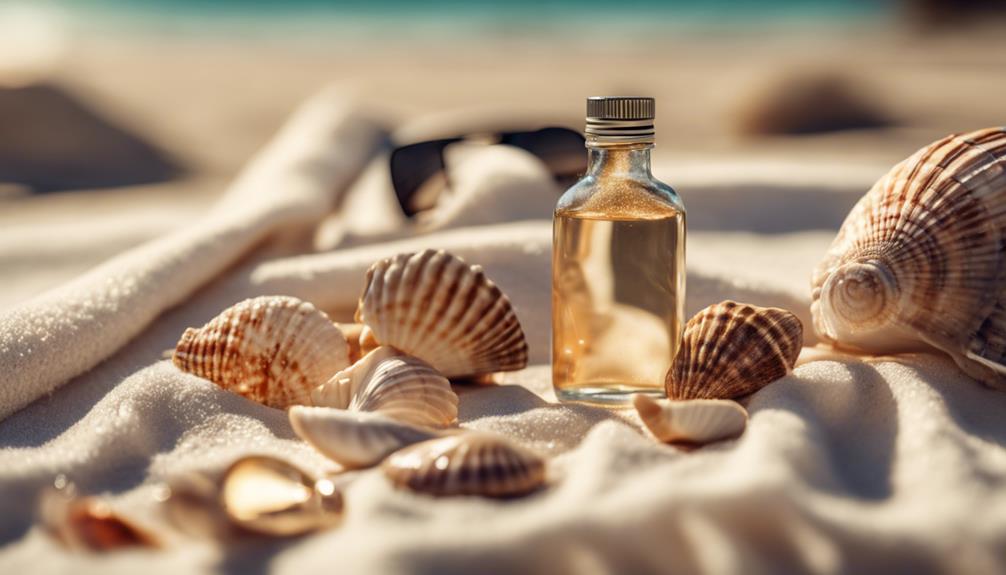To determine the optimal tanning times for your specific skin type, the first step is identifying it. If you have fair skin, it is recommended to limit tanning sessions to 5-7 minutes. Those with medium skin should start with 8-10 minutes and gradually increase. Darker skin tones can handle 15-20 minutes, but should always proceed with caution. Prepping your skin with exfoliation and moisturization before tanning is essential. Also, remember to wear protective eyewear and hydrate your skin afterward to maintain your glow. Monitoring for redness is crucial, as it indicates when it is time to reduce tanning time. There are many more tips to ensure your tanning experience is safe and effective—let’s delve into them further.
Key Takeaways
- For fair skin (Type 1), start with 5-7 minutes and increase gradually to avoid burns.
- Medium skin (Type 3) should begin tanning with 10-12 minutes, adjusting based on skin reaction.
- Darker skin (Type 5) can tan for 15-20 minutes, but should still proceed with caution.
- Always monitor your skin for redness and adjust tanning times accordingly.
Understanding Skin Types
Understanding your skin type is essential for safe and effective tanning, as it helps you tailor your approach to minimize risks and achieve the best results.
First, identify if you have fair, medium, or darker skin. Fair skin (Type 1) burns easily and needs minimal sun exposure. Medium skin (Type 3) tans more easily but should still start with shorter sessions. Darker skin (Type 5) can handle longer tanning times but should still be cautious.
Pay attention to how your skin reacts after each session; if you notice redness or irritation, it's time to reduce exposure.
Always use sunblock and moisturizers suited for your skin type to maintain health and enhance your tanning experience.
Tanning Bed Time Guidelines
Once you've identified your skin type, you can follow specific tanning bed time guidelines to guarantee a safe and effective tanning experience.
For Type 1 skin, start with 5-7 minute sessions, gradually increasing time to avoid burns.
Type 2 should begin with 8-10 minutes, slowly building from there.
If you have Type 3 skin, start with 10-12 minutes and adjust as needed.
Those with Type 4 can begin with 12-15 minutes, gradually extending their sessions.
For Type 5 skin, longer sessions of 15-20 minutes are acceptable, but still proceed cautiously.
Always listen to your skin's response to minimize risks and make sure you achieve that perfect tan safely.
Pre-Tanning Skin Preparation

Preparing your skin before tanning is essential for achieving a smooth, even glow and maximizing the effectiveness of your tanning sessions.
Start by exfoliating your skin to remove dead cells, which helps enhance your tan. Follow up with a good moisturizer to prevent dryness—hydrated skin tans better.
Avoid lotions containing oils, as they can hinder UV absorption. If you plan to use a bronzer lotion, choose one that suits your skin type and contains nourishing ingredients like DHA for a natural look.
Apply it evenly to guarantee consistent color. Don't forget to patch test any new products to check for sensitivities.
With these steps, you're setting yourself up for a successful tanning experience.
Skin Protection During Tanning
After ensuring your skin is prepped and ready, it's important to protect it during tanning to minimize the risk of burns and maintain skin health.
Use a gradual tanning approach; this helps you build color without overexposing your skin to harmful UV rays.
Keep your skin hydrated with lotions and moisturizers, which can reduce irritation and enhance your tan.
Always wear protective goggles to shield your eyes from UV damage; they're essential for safe tanning bed use.
Space out your tanning sessions to give your skin time to recover and avoid potential burns.
Post-Tanning Skin Care

Post-tanning skin care is essential for maintaining your glow and ensuring your skin stays healthy after exposure.
Start by gently cleansing your skin with a mild soap to remove any residue without stripping moisture. Pat your skin dry with a soft towel—avoid rubbing to prevent irritation.
Next, apply a rich moisturizer to hydrate your skin, locking in that beautiful tan. Stay hydrated by drinking plenty of water; this boosts your skin's radiance from the inside out.
Consider using tan extenders or after-tan lotions designed to prolong your tan.
Finally, remember to protect your skin type with appropriate sun protection to prevent premature aging and health risks.
Keeping your skin healthy is key to enjoying your tan longer!
Healthy Tanning Bed Alternatives
While maintaining your skin's health is important after tanning, exploring healthier alternatives to tanning beds can provide a safe way to achieve that sun-kissed glow.
Here are three options you might consider:
- Spray Tans: These offer instant color with no UV exposure, giving you a quick and even tan.
- Self-Tanning Lotions: Gradually develop your tan at home; simply apply the lotion as part of your skincare routine for a natural look.
- Bronzer Makeup: For a temporary solution, bronzer can enhance your skin tone and give you that radiant glow without any commitment.
Tanning Bed Safety Tips

To guarantee a safe tanning experience, always assess your skin type and start with shorter sessions to minimize the risk of burns.
Use protective eyewear to shield your eyes from harmful UV rays; goggles are a must.
Apply a suitable bronzer lotion to enhance your tan while keeping skin hydrated. Remember, hydration is key—moisturize before and after tanning to maintain skin health.
Space out your sessions to avoid overexposure, allowing your skin to recover. If you notice any irritation or unusual reactions, stop tanning immediately.
Finally, consult with a tanning professional for personalized advice tailored to your skin type, ensuring you get the best results while prioritizing your safety.
Enjoy your tanning with care!
Frequently Asked Questions
How Can I Identify My Skin Type Accurately?
To identify your skin type accurately, observe how your skin reacts to sun exposure. Notice if you burn easily or tan. Additionally, assess oiliness or dryness after cleansing, and consider genetics for further insights.
What Are the Long-Term Effects of Tanning Beds on Skin?
Did you know that indoor tanning increases your skin cancer risk by 75%? Over time, tanning beds can lead to premature aging, skin damage, and heightened cancer risk, so you've gotta prioritize your skin's long-term health.
Can I Tan if I Have Sensitive Skin?
Yes, you can tan with sensitive skin, but take precautions. Use a gentle approach, shorter sessions, and quality sunscreen. Always listen to your skin's reactions and adjust accordingly to avoid irritation or burns.
How Often Should I Tan for Optimal Results?
Isn't it tempting to chase that perfect glow? For ideal results, you should tan once or twice a week, listening to your skin's response, and gradually adjusting your sessions to maintain a healthy, radiant tan.
Are There Specific Foods That Enhance Tanning Results?
Certain foods can enhance tanning results. Incorporate carrots, tomatoes, and leafy greens into your diet; these foods boost skin health and melanin production. Staying hydrated with water also supports a glowing, even tan.
How Can Tanning Bronzers Enhance the Tanning Experience for Different Skin Types?
Experience the magic of tanning bronzers for different skin types. Whether you have fair or dark skin, tanning bronzers can enhance your tanning journey by providing a natural-looking, sun-kissed glow. With formulas designed for various skin tones, bronzers ensure a seamless, radiant tan every time. Try it and see the difference!
What is the Best Tanning Time for Different Skin Types?
When it comes to tanning, one size does not fit all. The best tanning time varies for different skin types. Fair skin burns easily and should limit tanning to early morning or late afternoon. Medium skin can tan for a bit longer, while dark skin can handle more sun exposure. Smart tanning tips for you!
Can the Tanning Bed Timing Guide also be used for natural tanning?
Yes, the safe tanning bed timing techniques can be used as a guide for natural tanning as well. By monitoring the time spent in the sun and gradually increasing exposure, it can help prevent sunburn and promote a healthy tan. Following these guidelines can help maintain a safe tanning experience.
Are the Tanning Times for Every Skin Type the Same for Tanning Beds?
When it comes to safe tanning bed timing, it’s important to consider your skin type. The safe tanning bed timing master recommends different durations for each skin type. Fair skin may require less time, while darker skin can handle longer sessions. It’s essential to follow the guidelines to avoid skin damage.
Conclusion
In the dance of sun and skin, knowing your type is your rhythm.
By understanding your unique needs and following the guidelines, you can waltz through your tanning sessions safely and effectively.
Remember, preparation and care are key to maintaining that golden glow while keeping your skin healthy.
So, embrace the sun or the tanning bed with confidence, and let your skin shine bright like a summer day, radiating beauty and warmth for all to see.










